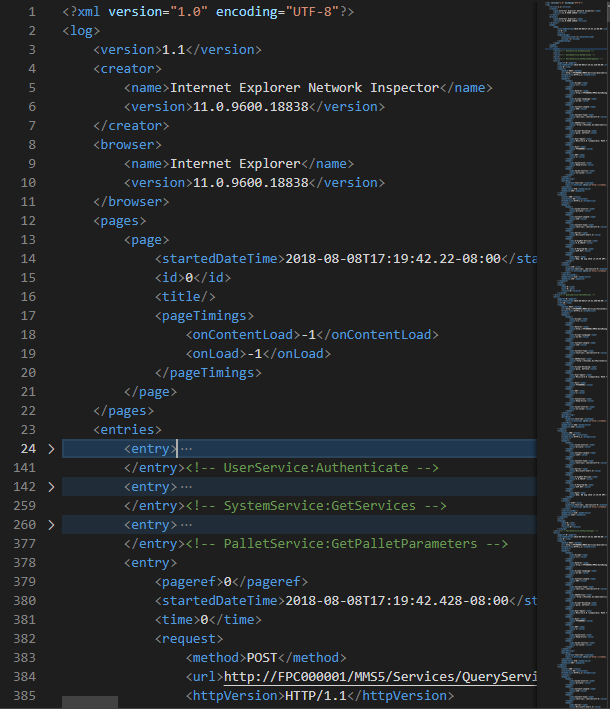Python SOAP Client for Fastems MMS5



Background
Here is a little background before the technical. I used to program and run a horizontal machining cell consisting of two identical Matsuura H+405s and a crane operated, 24 pallet storage container. This container system is designed by FASTEMS and it is an add-on type, third party system. Besides physically loading the machine, the system digitally interfaces with the machine, only really to transfer programs and command which one to run. The scheduling of jobs and pallets is done by the system, which works great, but someone has to input the jobs and quantities and dates. This was supposed to be done automatically by the ERP software, but it just... never happened.
The Problem
We as the operators, would need to take the routers, and input the jobs ourselves into the system. It's not that big of a deal, but that means there is a disconnect. The FASTEMS cell can have stale or inaccurate forecasts. It needs to know about all routed jobs. The interface is web-based but stuck on a pedestal in front of the container. Operating the touch interface as an dirty-handed machinist, it was not ideal. I dreaded using it. The keyboard was not positioned well for typing while standing, getting a track-ball helped with navigation, but still, it was a pain.
There Has to be a Better Way
Since I know that the interface is a web interface, that means there is a backend it communicates with. Let's open the console and investigate some of the requests being made. I found out that the interface was making SOAP requests to the backend and therefore, maybe I could replicate those requests. Here is a small snippet of one of the requests. (there is 3600+ lines of XML)
The main take away here is that if the MMS5 interface can communicate with http requests, then I can too. I have never attempted something like this before, but I know it's possible, so, let's get to work.
Deciding on an Implementation
I will say up front, that I am not "skilled" in python, but I know enough to utilize the language to do what I want. My initial research on packages that might help me create a SOAP client led me to Java, C#, .NET, but no language I knew very well. I know python has a huge package library, so let's look there. The first result was Zeep, which looked really promising. It could do authentication which I needed. I would be able to create a method for applying the headers relevant to pretend to be the MMS5 dashboard.
def egress(self, envelope, http_headers, operation, binding_options):
"""Tap outgoing request"""
ignore_at = datetime.now().strftime('%m-%d-%Y %H:%M:%S %p')
fastems_headers = {
'Accept': '*/*',
# 'SOAPAction': operation.soapaction,
'Referer': 'http://%s/MMS5/DataManager.xap?ignore=%s' % (config.FASTEMS_HOSTNAME, ignore_at),
'Accept-Language': 'en-US',
'Accept-Encoding': 'gzip, deflate',
'User-Agent': 'Mozilla/4.0 (compatible; MSIE 7.0; Windows NT 6.1; WOW64; Trident/7.0; SLCC2; .NET CLR 2.0.50727; .NET CLR 3.5.30729; .NET CLR 3.0.30729; .NET4.0C; .NET4.0E; McAfee; InfoPath.2)',
'Host': config.FASTEMS_HOSTNAME,
'DNT': '1',
'Connection': 'Keep-Alive',
'Cache-Control': 'no-cache'
}
From this point I was able to make basic requests to the backend! I was using small scripts to make one off requests, with it evolving as I used it. After creating a class to house the custom client...
def build_client(service) -> (Client, HistoryPlugin):
'''Create a new Zeep client with history based on a service name'''
history = HistoryPlugin()
session = Session()
session.auth = HTTPBasicAuth(config.DATA_MANAGER_USER, config.DATA_MANAGER_PASS)
transport = Transport(cache=SqliteCache(), session=session)
wsd_uri = 'http://%s/MMS5/Services/%s.svc?wsdl' % (config.FASTEMS_HOSTNAME, service)
plugins = [FastemsHeadersPlugin(), history]
return Client(wsd_uri, transport=transport, plugins=plugins), history
Then we add a method to request the WSDL of the given service endpoint, parse the output, and generate some method definitions for a service class.
def generate_methods(service):
methods = []
print('Building %s Zeep Client' % service)
client, history = build_client(service)
for service in client.wsdl.services.values():
for port in service.ports.values():
operations = sorted(
port.binding._operations.values(),
key=operator.attrgetter('name'))
for operation in operations:
print(operation.__dict__)
m = re.match(r'([a-zA-Z]+)\((.+)?\)', str(operation))
if m:
param_def = ''
params = ''
if m.group(2):
param_def = m.group(2).split(', ')
params = ', '.join([p.split(': ')[0] for p in param_def])
methods.append({
'method_name': m.group(1),
'params': params,
'param_def': param_def
})
return methods
Now that we have all the endpoints and arguments, we can create classes to map onto each one, and provide a rich collection of classes with API endpoints bound to corresponding methods. So, lets use some templates, and write it all out to our project for consumption.
def generate_class_files():
class_template_file = './py_templates/class.tmpl'
method_template_file = './py_templates/method.tmpl'
for service in __all__:
service_class_file = './%s.py' % service
methods = generate_methods(service)
print('Creating %s' % service_class_file)
with open(class_template_file, 'r') as class_template, \
open(method_template_file, 'r') as method_template, \
open(service_class_file, 'w') as new_class:
method_str = method_template.read()
new_class.write(class_template.read().format(service_name=service))
new_class.write('\n')
for method in methods:
print('[%s] Adding %s()' % (service, method['method_name']))
new_class.write(method_str.format(**method))
new_class.write('\n')
print('Done!\n')
Running this script produced a set of 18 class files with fully defined members, all similar looking to the following. This was a huge win for me!
from fastems import services
class OrderService(services.FastemsService):
def __init__(self):
super().__init__('OrderService')
def BookScrapParts(self, requestor, scrapRequest):
'''['requestor: ns2:RequestorDto', 'scrapRequest: ns3:BookScrapPartRequestDto']'''
return self._client.service.BookScrapParts(requestor, scrapRequest)
def CreateOrder(self, requestor, request):
'''['requestor: ns2:RequestorDto', 'request: ns3:CreateOrderRequestDto']'''
return self._client.service.CreateOrder(requestor, request)
def DeleteCompletedOrders(self, requestor):
'''['requestor: ns2:RequestorDto']'''
return self._client.service.DeleteCompletedOrders(requestor)
def DeleteOrder(self, requestor, orderId):
'''['requestor: ns2:RequestorDto', 'orderId: ns3:OrderIdentityDto']'''
return self._client.service.DeleteOrder(requestor, orderId)
def GetOrders(self, ids):
'''['ids: ns7:ArrayOfguid']'''
return self._client.service.GetOrders(ids)
def GetOrdersForOperation(self, operationId):
'''['operationId: ns4:guid']'''
return self._client.service.GetOrdersForOperation(operationId)
def GetSettings(self):
''''''
return self._client.service.GetSettings()
def SaveSettings(self, requestor, settings):
'''['requestor: ns2:RequestorDto', 'settings: ns3:OrderSettingsDto']'''
return self._client.service.SaveSettings(requestor, settings)
def UpdateOrder(self, requestor, request):
'''['requestor: ns2:RequestorDto', 'request: ns3:UpdateOrderRequestDto']'''
return self._client.service.UpdateOrder(requestor, request)
Conclusion
I am very happy with how the code works and how all my service classes are generated for me. Automation is key so we can generate the building blocks and free up our time to build bigger and better things. The repository is available here if you want to look through the source.
The following video is a recording of this script running against the FASTEMS backend as a proof of concept video for management.
